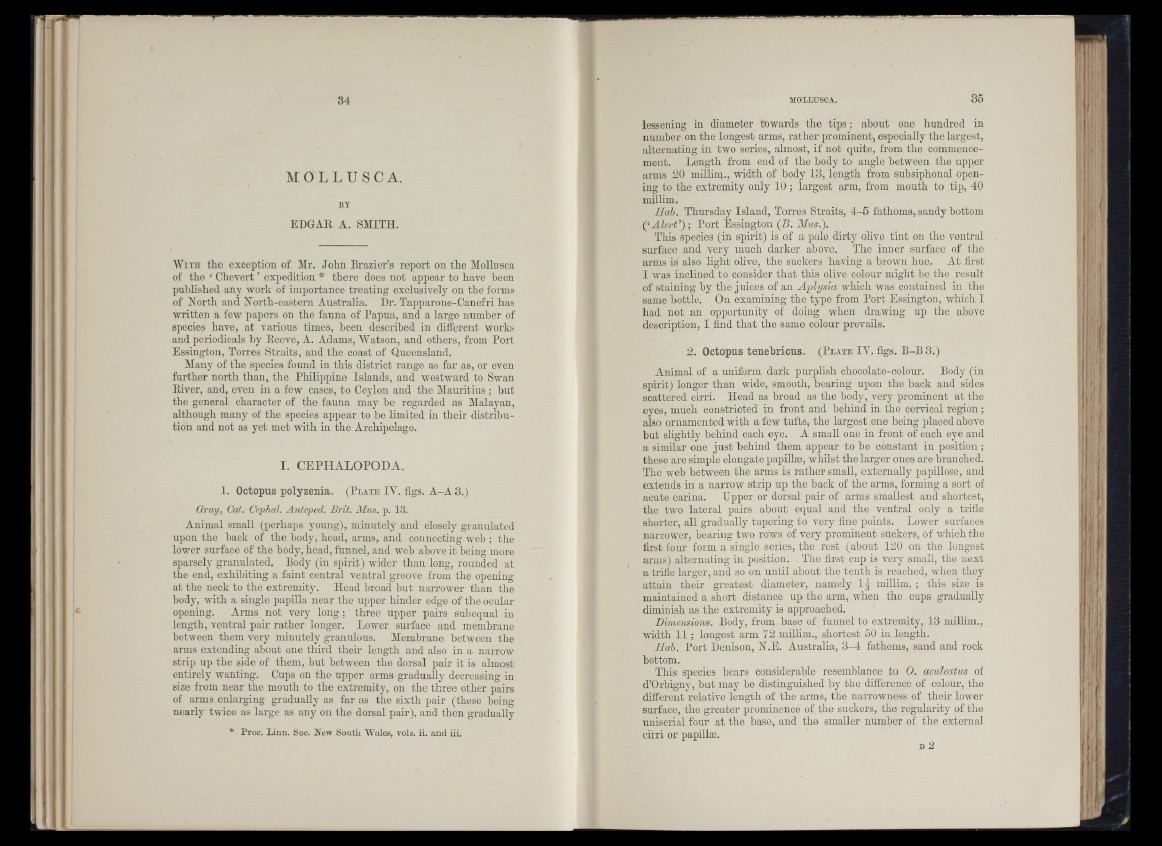
MO L L U S C A .
BY
EDGAR A. SMITH.
I
With the exception of Mr. John Brazier’s report on the Mollusca
of the ‘ Chcvert ’ expedition * there does not appear to have been
published any work of importance treating exclusively on the forms
of North and North-eastern Australia. Dr. Tapparone-Canefri has
written a few papers on the fauna of Papua, and a large number of
species have, at various times, been described in different works
aud periodicals by Reeve, A. Adams, Watson, and others, from Port
Essington, Torres Straits, and the coast of Queensland.
Many of the species found in this district range as far as, or even
further north than, the Philippine Islands, and westward to Swan
River, and, even in a few cases, to Ceylon and the Mauritius; hut
the general character of the fauna may he regarded as Malayan,
although many of the species appear to be limited in their distribution
and not as yet met with in the Archipelago.
I. CEPHALOPODA.
* j
j i
l i i i
1. Octopus polyzenia. (Plate lY. figs. A-A 3.)
Gray, Cat. Cephal. Anteped. Brit. Mus. p. 13.
Animal small (perhaps young), minutely and closely granulated
upon the back of the body, head, arms, and connecting w e b ; the
lower surface of the body, head, funnel, and web above it being more
sparsely granulated. Body (in spirit) wider than long, rounded at
the end, exhibiting a faint central ventral groove from the opening
at the neck to the extremity. Head broad but narrower than the
body, Avith a single papilla near the upper hinder edge of the ocular
opening. Arms not very lo n g ; three upper pairs subequal in
length, ventral pair rather longer. Lower surface and membrane
between them very minutely granulons. Membrane between the
arms extending about one third their length and also in a narroAv
strip up the side of them, hut between the dorsal pair it is almost
entirely wanting. Cups on the upper arms gradually decreasing in
size from near the mouth to the extremity, on the three other pairs
of arms enlarging gradually as far as the sixth pair (these being
nearly twice as large as any on the dorsal pair), and then gradually
* Proc. Linn. Soc. New South Wales, vols. ii. aud iii.
lessening in diameter towards the tip s ; about one hundred in
number on the longest arms, rather prominent, especially the largest,
alternating in two series, almost, if not quite, from the commencement.
Length from end of the body to angle between the upper
arms 20 millim., width of body 13, length from subsiphonal opening
to the extremity only 1 0 ; largest arm, from mouth to tip, 40
millim.
Hah. Thursday Island, Torres Straits, 4 -5 fathoms, sandy bottom
{‘A le rt’); Port Essington {B. Mus.).
This species (in spirit) is of a pale dirty olive tin t on the ventral
surface and very much darker above. The inner surface of the
arms is also light olive, the suckers having a broAvn hue. At first
I Avas inclined to consider th a t this olive colour might he the result
of staining by the juices of an Aplysia which was contained in the
same bottle. On examining the type from Port Essington, Avhich I
had not an opportunity of doing when drawing up the above
description, I find th at the same colour prevails.
2. Octopus tenebricus. (P late IV. figs. B-B 3.)
Animal of a uniform dark purplish chocolate-colour. Body (in
spirit) longer than wide, smooth, bearing upon the back and sides
scattered cirri. Head as broad as the body, very prominent at the
eyes, much constricted in front and behind in the cervical region ;
also ornamented with a few tufts, the largest one being placed above
but slightly behind each eye. A small one in front of each eye and
a similar one ju s t behind them appear to he constant in position ;
these are simple elongate papillae, whilst the larger ones are branched.
The Aveb between the arms is rather small, externally papillose, and
extends in a narrow strip up tlie back of the arms, forming a sort of
acute carina. Upper or dorsal pair of arms smallest and shortest,
tho tAvo lateral pairs about equal and the ventral only a trifle
shorter, all gradually tapering to very fine points. LoAver surfaces
narrower, bearing two rows of very prominent suckers, of Avhich the
first four form a single series, the rest (about 120 on the longest
arms) alternating in position. The first cup is very small, the next
a trifle larger, and so on until about the tenth is reached, Avhen they
attain their greatest diameter, namely Ig millim. ; this size is
maintained a short distance up the arm, when the cups gradually
diminish as the extremity is approached.
Dimensions. Body, from base of funnel to extremity, 13 millim.,
width 1 1 ; longest arm 72 milhm., shortest 50 in length.
Hah. Port Denison, N.E. Australia, 3 -4 fathoms, sand and rock
bottom.
This species bears considerable resemblance to 0. aculeatus of
d’Orbigny, h a t may he distinguished by the difference of colour, the
different relative length of the arms, the narrowness of their lower
surface, the greater prominence of the suckers, the regularity of the
nuiserial four at the base, and the smaller number of the external
cirri or papillae.
11
( '
t te ■ n i , ^
i i I
I